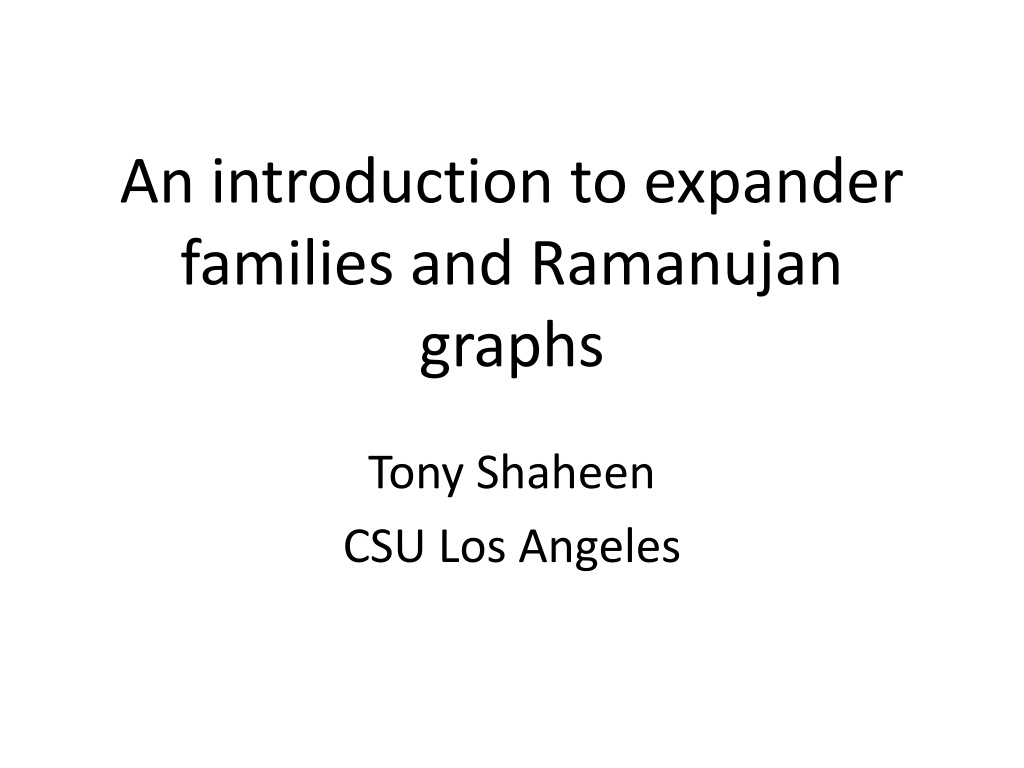Understanding Expander Families and Ramanujan Graphs
An introduction to expander families and Ramanujan graphs by Tony Shaheen from CSU Los Angeles. The discussion covers the concept of regular graphs, motivation behind expander families, communication networks, and the goal of creating an infinite sequence of d-regular graphs optimized for communication efficiency.
Download Presentation

Please find below an Image/Link to download the presentation.
The content on the website is provided AS IS for your information and personal use only. It may not be sold, licensed, or shared on other websites without obtaining consent from the author. Download presentation by click this link. If you encounter any issues during the download, it is possible that the publisher has removed the file from their server.
E N D
Presentation Transcript
An introduction to expander families and Ramanujan graphs Tony Shaheen CSU Los Angeles
Before we get started on expander graphs I want to give a definition that we will use in this talk. A graph is regular if every vertex has the same degree (the number of edges at that vertex). A 3-regular graph.
Now for the motivation behind expander families Think of a graph as a communications network.
Two vertices can communicate directly with one another iff they are connected by an edge.
Communication is instantaneous across edges, but there may be delays at vertices.
Our goal: Let d be a fixed integer with d > 1. Create an infinite sequence of d-regular graphs ?1, ?2, ?3, ?4, ?5, where 1. the graphs are getting bigger and bigger (the number of vertices of ?? goes to infinity as n goes to infinity) 2. each ?? is as good a communications network as possible.
Questions: 1. How do we measure if a graph is a good communications network? 2. Once we have a measurement, can we find graphs that are optimal with respect to the measurement?
Questions: 1. How do we measure if a graph is a good communications network? 2. Once we have a measurement, how good can we make our networks? Let s start with the first question.
Lets look at the set of vertices that we can reach after n steps, starting at the top vertex.
We would like to have many edges going outward from there.
Take-home Message #1: The expansion constant is one measure of how good a graph is as a communications network.
We want h(X) to be BIG! If a graph has small degree but many vertices, this is not easy.
Consider the cycles graphs: ?4 ?5 ?6 ?3
Consider the cycles graphs: ?4 ?5 ?6 ?3 Each is 2-regular.
Consider the cycles graphs: ?4 ?5 ?6 ?3 Each is 2-regular. The number of vertices goes to infinity.
We say that a sequence of regular graphs is an expander family if All the graphs have the same degree The number of vertices goes to infinity such that the expansion constant is always at least r. There exists a positive lower bound r
We just saw that expander families of degree 2 do not exist.
We just saw that expander families of degree 2 do not exist. What is amazing is that if d > 2 then expander families of degree d exist.
We just saw that expander families of degree 2 do not exist. What is amazing is that if d > 2 then expander families of degree d exist. Existence: Pinsker 1973 First explicit construction: Margulis 1973
So far we have looked at the combinatorial way of looking at expander families. Let s now look at it from an algebraic viewpoint.
We form the adjacency matrix of a graph as follows:
Facts about eigenvalues of a d-regular graph G: connected graph G with n vertices: Facts about the eigenvalues of a d-regular
Facts about eigenvalues of a d-regular graph G: G with n vertices: connected graph G with n vertices: Facts about eigenvalues of a d-regular gra Facts about the eigenvalues of a d-regular They are all real.
Facts about the eigenvalues of a d-regular connected graph G with n vertices: They are all real. The eigenvalues satisfy ? ?? 1 ?? 2 ?1<?0 = d
Facts about eigenvalues of a d-regular graph G: connected graph G with n vertices: Facts about the eigenvalues of a d-regular They are all real. The eigenvalues satisfy ? ?? 1 ?? 2 ?1<?0 = d The second largest eigenvalue satisfies (Alon-Dodziuk-Milman-Tanner)
The red curve has a horizontal asymptote at 2 ? 1
In other words, is asymptotically 2 ? 1 ?1 the smallest that can be.
We say that a d-regular graph X is Ramanujan if all the non-trivial eigenvalues of X (the ones that aren t equal to d or -d) satisfy ? |?| 2 ? 1
Hence, if X is Ramanujan then ?1 2 ? 1
Take-home Message #3: Ramanujan graphs essentially have the smallest possible ?1
























